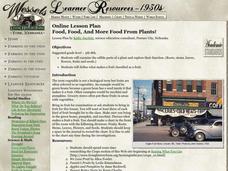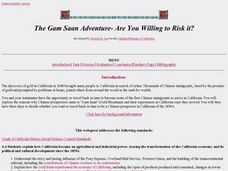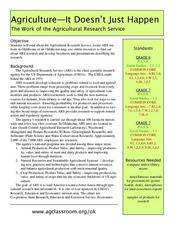Curated OER
How Should Our Gardens Grow?
Students examine different types of land use by humans and evaluate the ways land is used in their local community. They also consider the environmental effects of the different types of land use. Students assume the role of community...
Curated OER
Earth: The Food We Eat, The Seeds We Sow
High schoolers explore the importance of seed diversity for cultural and ecological stability/health. They discover what an heirloom seed is and why they are important to conserve.
Curated OER
Food, Food, And More Food From Plants!
Learners examine the edible parts of a plant and explore their function. They define what makes a fruit classified as a fruit. They create a sketch or map or photo of a 1930s farm and justify their plant selections.
Curated OER
Contours, Curves & Lines
Learners discover how straight lines and curves function in both art and the science of conservation tillage by building model "hills" and experimenting on them.
Curated OER
Egypt's golden Empire
Learners explore many of the key scientific and technological contributions made by the ancient Egyptians. Researched data is presented to the entire group.
Curated OER
THE GAM SAAN ADVENTURE ARE YOU WILLING TO RISK IT?
Fourth graders study the lasting influence of the Pony Express, Overland Mail Service, Western Union, and the building of the transcontinental railroad, including the contributions of Chinese workers to its construction. They explore the...
Curated OER
Agriculture in Idaho: Its Importance And Development From Historical Times To the Present
Fourth graders examine importance agriculture is in their own lives and about its importance in the history of Idaho from its beginnings through the present.
Curated OER
The Cream of the Crop
Students read and discuss article, "Simple Method Found to Vastly Increase Crop Yields," then research the basic components of conventional and organic agricultural methods. They, in groups, organize and present their research to the class.
Curated OER
The "New" McDonald's Farm
This is a very cute spin-off on the classic, "Old McDonald Had a Farm" song. As a way of updating young peoples' images of farmers, learners are encouraged to make up a new version of the song that uses current images and language. A...
Curated OER
Plant Science Chapter #1
It may not stand as a cohesive presentation, but individually you may find a use for these slides. One slide describes how civilization began once man learned to plant and harvest food. Another explores the population growth over time....
Curated OER
Lesson: Living With the Farm Next Door
Discuss with learners why farms are growing in size and why there is sometimes conflict between farmers and their non-farming neighbors. Read the article, "Living With the Farm Next Door," and then craft letters to the editor from the...
Curated OER
Fresh Produce North of 60
Teen-agers discuss how fresh produce is brought into areas that do not have agreeable growing conditions and read an article from Canadian Agriculture at a Glance. They write an essay about projects that may help provide food in these...
Curated OER
They're Tilling that Field Behind the Mall
Unfortunately, the article for which this resource was written is not available. You can, however, find another current document on agriculture and urban development for your class to read together, and then still follow the suggested...
Curated OER
Old Farming Tools
A simple handout on old farming tools contains four framing tools: a scythe, a mortar and pestle, a digging stick, and a plow. There is an illustration of each tool which is also labelled.
Curated OER
Snack Search
Students make maps to show where the agricultural products used to produce various packaged snacks are grown. They bring in snacks from home and utlize a worksheet imbedded in this plan.
Curated OER
Traveling as an Ancient American
What would you bring on a trip...if you had to carry it all through freezing temperatures for 3 months? Historians consider this question, faced with their family's need to move south for warmer temperatures in the ancient world....
Curated OER
Where in the World?
Students evaluate botany by participating in a class discussion. In this agriculture instructional activity, students identify the importance of knowing where food comes from and they discuss what their breakfast consisted of and where...
Curated OER
Agriculture - It Doesn't Just Happen
Sixth graders examine the role of the US Department of Agriculture. In this United States Agriculture lesson, 6th graders create maps with sites and specialty areas. Students create a presentation on the topic they were given to research.
Curated OER
What Parts Are There to a Plant?
Learners explore botany by completing plant science worksheets. In this plant anatomy lesson, students examine real vegetables in class using magnifying glasses. Learners identify the plants anatomy and complete worksheets discussing...
Curated OER
National Worm Survey
Learners participate in the National Worm Survey. In this National Worm Survey lesson plan, students generate data on earthworms. Learners submit their data to the online database Worm Watch.
Curated OER
Food Systems Feed the World
Sixth graders consider the source of their nutrition. In this food systems lesson plan, 6th graders discuss how food gets to the table and the process it goes through. Students reflect on world hunger issues, farming, and consumerism...
Curated OER
Who's Who?
Students explore biology by identifying animals and their environments. In this animal characteristic instructional activity, students read assigned text about farm animals, how they are raised, and what they are used for in our society....
Curated OER
Pizza Time!
Fifth graders explore healthy dietary guidelines. In this dietary guidelines lesson, 5th graders investigate fractional parts of a healthy diet using pizza as a visual aid.
Curated OER
Next Year's Seeds
Fifth graders explore genetic traits. In this genetic traits lesson, 5th graders discover how traits are passed from parent to offspring while examining plants. Students problem solve real world applications.

























